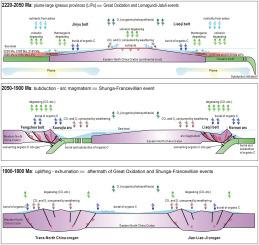Earth-Science Reviews ( IF 10.8 ) Pub Date : 2023-02-08 , DOI: 10.1016/j.earscirev.2023.104352 Peng Peng , Xu Liu , Lianjun Feng , Xiqiang Zhou , Hongwei Kuang , Yongqing Liu , Jianli Kang , Xinping Wang , Chong Wang , Ke Dai , Huichu Wang , Jianrong Li , Peisen Miao , Jinghui Guo , Mingguo Zhai

|
To better understand the sustaining mechanism of the Great Oxidation Event (GOE), strata and igneous suites especially large igneous provinces (LIPs) during the GOE's late stage, known as the Lomagundi-Jatuli event (LJE), in the eastern North China craton (NCC) are investigated and reviewed. New results approve a span of ca. 200 Ma for the LJE-traced strata, including the lower Gaofan Group during 2270–2185 Ma, the lower-middle Sanchazi-Machollyong groups during 2185–2125 Ma and the lower-middle Hutuo Group during 2125–2025 Ma. The entirety of the LJE of the NCC intermits and spatially correlates with the emplacement of LIPs at ca. 2220 Ma, ca. 2185 Ma, ca. 2145 Ma, ca. 2120 Ma, ca. 2090 Ma, and ca. 2060 Ma during a global LIP peak of 2250–2050 Ma. These igneous suites are featured by subaqueous-extrusions, with prominent volcaniclastics and volcanic ashes (tuffs), which enhanced nutrient elements' input (such as Co, Ni, and V). The igneous suites have thus potentially contributed to keep the primary bioproductivity and then the accumulation of organic matters in the sediments and oxygenation-status of atmosphere. The end of this period was partly coincident with and closely followed by the arising of subduction system and orogenic processes during 2050–1800 Ma, which were responsible for the forming of major graphite-ore deposits followed by melting and converting of buried organic carbon into carbon dioxide. A blooming of arc magmatism and weathering of exhumed arc roots and orogens while a retreating of LIPs during 2050–1800 Ma might have elevated recyclability of organic carbon during high-temperature metamorphism and back into Earth surface via arc magmatism, favoring the causally termination of the GOE-LJE.
中文翻译:

Rhyacian间歇性大火成岩省持续的大氧化事件:来自华北克拉通的证据
为了更好地理解大氧化事件(GOE)的维持机制,在大氧化事件(GOE)晚期,即Lomagundi-Jatuli事件(LJE),地层和火成岩组特别是大火成岩省(LIPs)在华北克拉通东部( NCC)进行调查和审查。新结果批准了 ca 的跨度。LJE 示踪地层为 200 Ma,包括 2270~2185 Ma 的高饭群下部、2185~2125 Ma 的中下三岔子-马哲梁群和 2125~2025 Ma 的中下部滹沱群。NCC 的整个 LJE 间断并在空间上与 LIP 的位置相关。2220 Ma,约 2185 Ma,约 2145 Ma,约 2120 Ma,约 2090 Ma,约 2060 Ma 在 2250–2050 Ma 的全球 LIP 峰值期间。这些火成岩套房的特点是水下挤压,具有显着的火山碎屑和火山灰(凝灰岩),增强了营养元素(如 Co、Ni 和 V)的输入。因此,火成岩套房可能有助于保持初级生物生产力,然后是沉积物中有机物的积累和大气的氧合状态。这一时期的结束与 2050-1800 Ma 期间俯冲系统和造山过程的出现部分重合并紧随其后,这导致了主要石墨矿床的形成,随后将掩埋的有机碳熔化并转化为碳二氧化碳。











































 京公网安备 11010802027423号
京公网安备 11010802027423号